Nepal's majestic Himalayan range is adorned with a multitude of peaks that span an elevation spectrum from 6000 meters (approximately 19,685 feet) to 6999 meters (approximately 22,962 feet). Within this breathtaking expanse, there exists a treasure trove of 297 peaks that proudly stand at 6000 meters or higher. These peaks, both those conquered and those awaiting their first ascent, beckon adventurers from around the world to embrace the thrill of high-altitude climbing.
Among these towering summits, 270 are under the custodianship of the Department of Tourism, while the Nepal Mountaineering Association (NMA) oversees the remaining 27. The allure of these peaks extends beyond seasoned climbers, opening doors of opportunity for amateur and novice mountaineers to embark on high-altitude endeavors. These peaks, often referred to as "Trekking Peaks," offer a unique proposition—challenging Himalayan climbs without the complexities associated with extensive logistical arrangements.
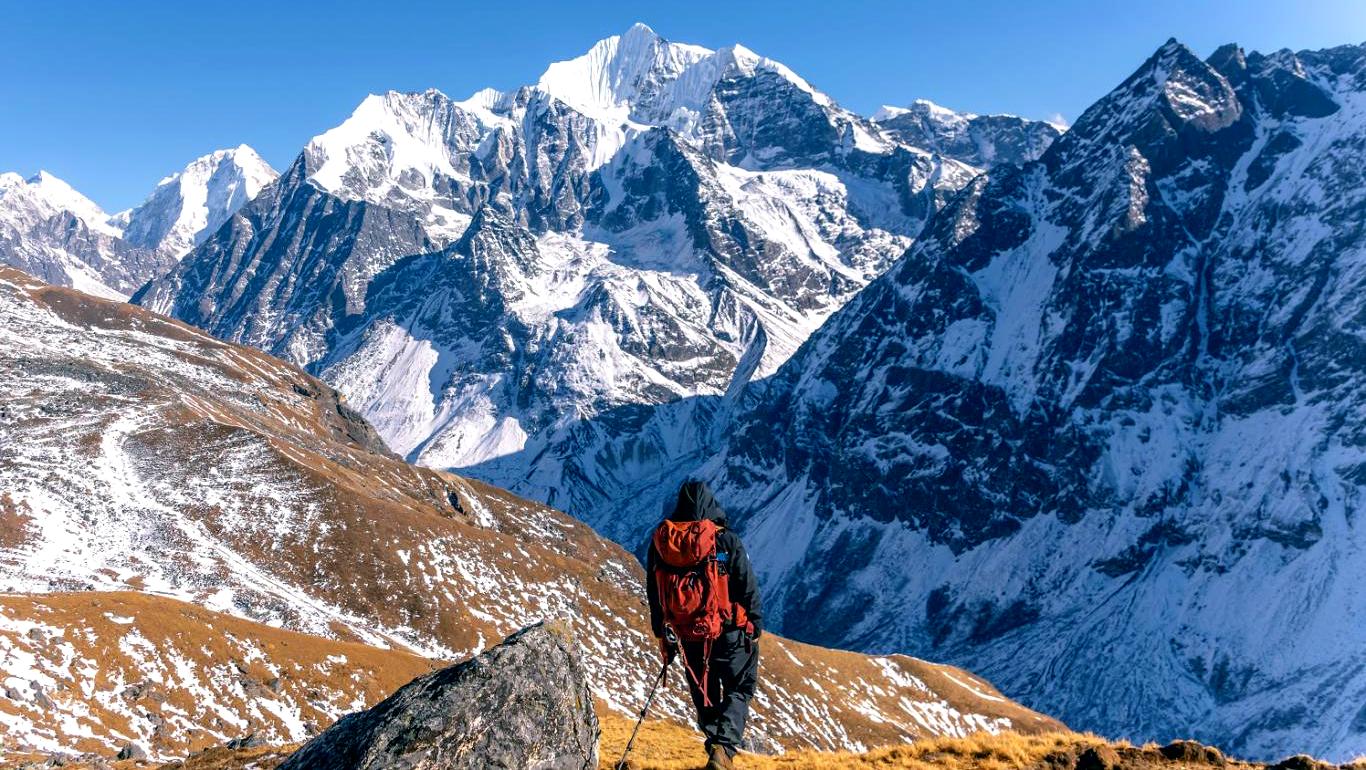
The significance of these 6000-meter summits lies not just in the exhilaration they offer, but also in their role as stepping stones towards loftier aspirations. They serve as ideal training grounds, a vital prerequisite for those aiming to ascend peaks between 7000 and 8000 meters. The challenges presented by these 6000-meter summits are no less formidable than those posed by their higher counterparts; they demand meticulous training, careful planning, and a profound respect for the unpredictable nature of the mountains.
Venturing into the realm of 6000-meter peaks provides an unparalleled opportunity to experience the raw power and beauty of the Himalayas. It's an invitation to forge a connection with the immense forces of nature, while simultaneously testing one's limits and abilities. As the wind sweeps through the towering ridges and glaciers, and the vastness of the landscape unfolds before the intrepid climber, each step becomes a testament to human determination and resilience. These peaks are a reminder that while the heights of the world's highest mountains are a privilege reserved for the most experienced, the realm of the 6000-meter summits offers a bridge between the aspirations of aspiring climbers and the majesty of the world's highest peaks.
Island Peak (Imja Tse) 6,189 meters (20,305 feet)
Island Peak, also known as Imja Tse, stands as a revered emblem within Nepal's Everest region. Its striking prominence and unique contours set it apart as a distinctive trekking peak that entices both climbers and trekkers. Nestled amidst the Everest realm, Island Peak's allure is twofold: its picturesque shape and the breathtaking panorama it unveils. As climbers ascend their slopes, they're met with a panoramic spectacle that includes the awe-inspiring Everest and its neighboring peaks. The summit's vantage point provides an unrivaled perspective of the Himalayan expanse, inviting those who undertake the journey to become part of its storied legacy.
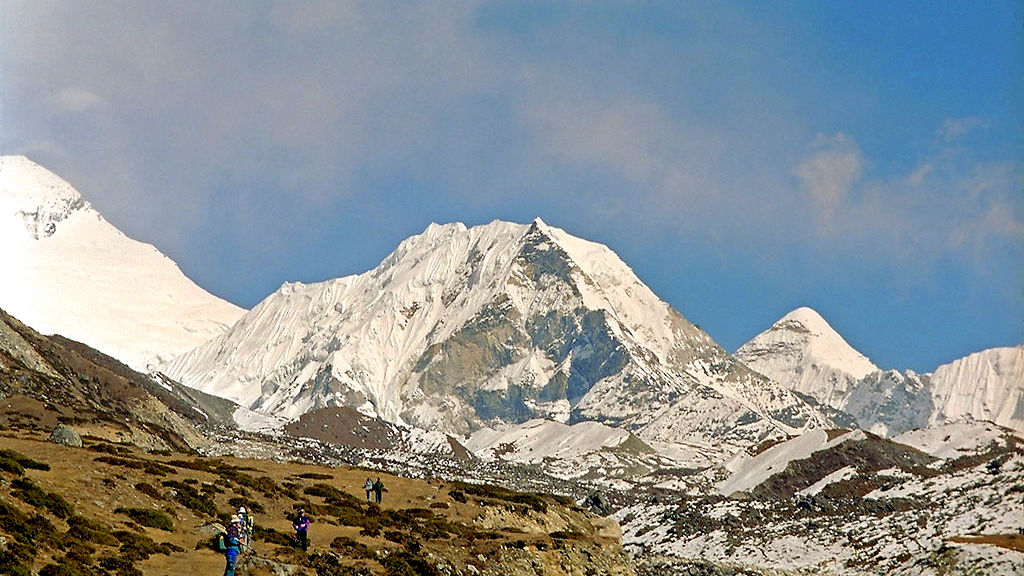
For adventurers seeking to stand in the shadows of giants, Island Peak's allure is magnetic. The journey unfolds through the mesmerizing landscapes of the Everest region, captivating trekkers with its cultural tapestry and natural grandeur. Climbers, on the other hand, face the formidable challenge of ascending its heights, navigating technical aspects with respect for the mountain's power. Island Peak's ascent encapsulates not only the thrill of conquering a summit but also the reverence one feels in the presence of the world's highest peaks. This convergence of natural beauty, physical endeavor, and spiritual resonance has made Island Peak a cherished destination, where the aspirations of climbers and the grandeur of the Himalayas collide in unforgettable harmony.
Some Facts About Island Peak (Imja Tse):
- Elevation: Approximately 6,189 meters (20,305 feet)
- Location: Everest region
- Mountain Views: Stunning views of Everest and surrounding peaks
- Difficulty: Moderate to challenging; some technical sections require basic climbing skills
Mera Peak 6,476 meters (21,247 feet)
Mera Peak, an emblem of majestic allure, reigns supreme within the heart of Nepal's Khumbu region. As the loftiest trekking peak in the country, it commands attention with its towering grandeur and promises an expedition that blends challenge and reward in equal measure. Perched amid the legendary Khumbu, Mera Peak beckons to both seasoned mountaineers and aspiring adventurers alike, inviting them to embark on an odyssey that transcends the ordinary.
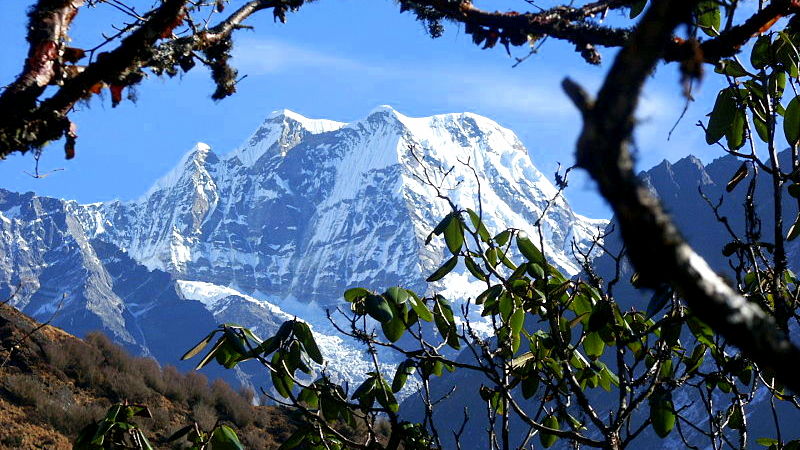
Rising to meet the heavens, Mera Peak's ascent presents a formidable climb, offering a true test of mountaineering prowess. As climbers navigate its precipitous paths and ascend to the summit, they're granted a vantage point that few have witnessed. The view that unfurls before them is nothing short of breathtaking—five of the world's six highest mountains, including the illustrious Everest, Lhotse, and Makalu, stand as monumental sentinels of the Himalayan realm. Each peak shares its story through the interplay of light and shadow, and as the air resonates with the echo of ascending souls, Mera Peak's summit becomes a sanctuary where mountaineers bask in the glory of nature's most profound masterpiece.
Some Facts About Mera Peak:
- Elevation: Approximately 6,476 meters (21,247 feet)
- Location: Khumbu region
- Mountain Views: Breathtaking vistas of Everest, Lhotse, Makalu, and more
- Difficulty: Non-technical climb but requires basic mountaineering skills and acclimatization
Lobuche Peak East 6,119 meters (20,075 feet), and Lobuche West 6,145 meters (20,161 feet)
Nestled within the revered Everest region, Lobuche Peak emerges as a twin-peaked gem, offering intrepid climbers an exquisite duet of challenges and rewards. This formidable peak is a symphony of adventure, where climbers can choose between its two majestic summits: Lobuche East and Lobuche West. As the curtains of the Everest region unveil their splendor, Lobuche Peak takes center stage, promising an ascent that resonates with both grandeur and accomplishment.

Lobuche East and Lobuche West stand as two distinct chapters in the saga of Himalayan exploration. Each summit embodies its own set of challenges and opportunities, inviting climbers to choose their preferred narrative. Regardless of the chosen path, both summits bestow panoramic vistas of the towering Everest range—a visual symphony of peaks that traverse the horizon. The scene is set, and as climbers ascend, the Himalayan drama unfolds, with Everest, Lhotse, and their companions etching their stories across the sky. Lobuche Peak's summits stand as beacons of accomplishment, rewarding those who brave its heights with views that transcend the ordinary and resonate with the spirit of mountain conquest.
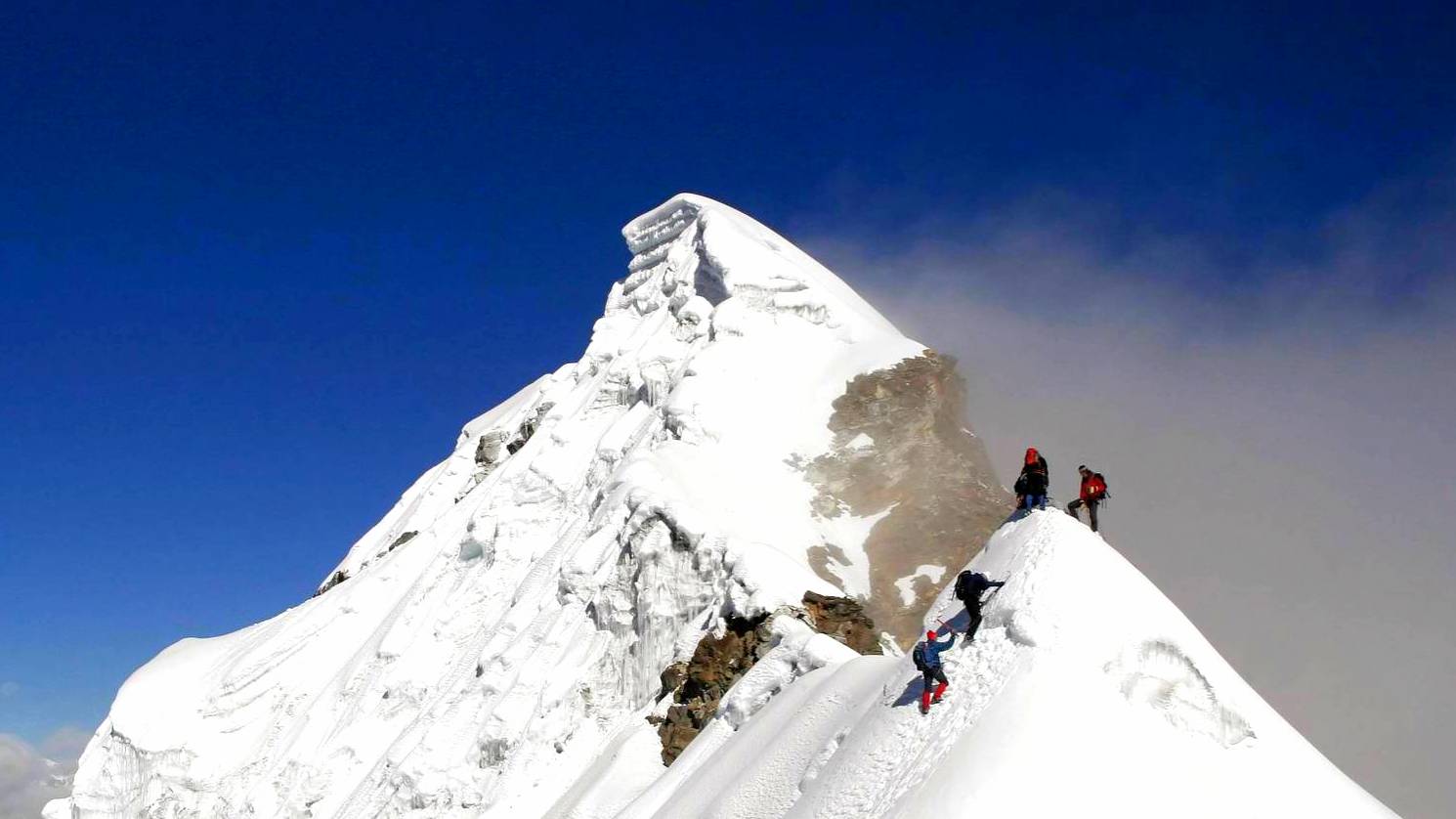
Some Facts About Lobuche Peak:
- Elevation (Lobuche East): Approximately 6,119 meters (20,075 feet)
- Elevation (Lobuche West): Approximately 6,145 meters (20,161 feet)
- Location: Everest region
- Mountain Views: Panoramic vistas of the Everest range
- Difficulty: Varied routes, suitable for climbers with basic mountaineering skills
Yala Peak 5,732 meters (18,806 feet)
Perched within the enchanting embrace of the Langtang region, Yala Peak emerges as a gateway to the Himalayan realm, welcoming novice climbers and trekkers with open arms. This peak, renowned for its accessibility and approachability, extends an invitation to those seeking their first taste of high-altitude adventure. Amidst the rugged landscapes of Langtang, Yala Peak stands as a beacon of opportunity, promising a climb that balances challenge and awe in perfect harmony.
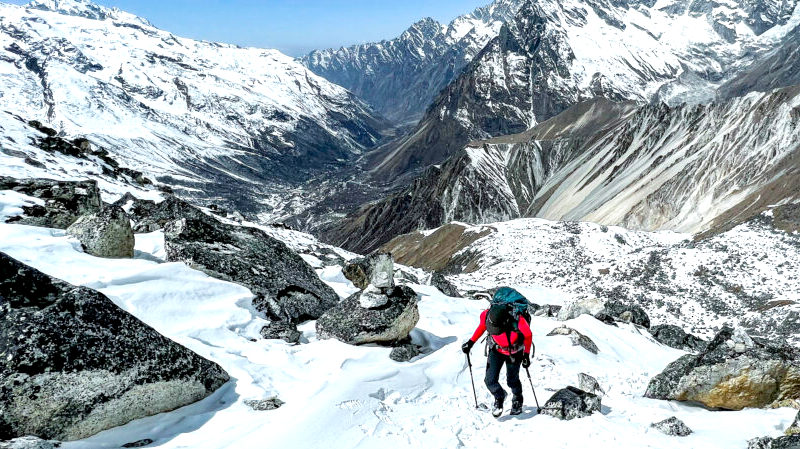
Yala Peak's ascent presents a relatively straightforward journey, making it an ideal choice for those stepping into the world of Himalayan climbing. While the climb demands effort and dedication, the path is navigable, providing an introduction to the techniques and skills required for higher summits. As climbers ascend, the landscapes unfold like a captivating tapestry, revealing the snow-cloaked Langtang Lirung and an array of other peaks that grace the horizon. The vistas are nothing short of spectacular—a visual feast that rewards climbers for their perseverance and courage. Yala Peak's summit becomes a vantage point where the Langtang region's beauty takes center stage, and the echoes of past adventurers blend with the whispers of the mountains, creating a symphony of discovery and triumph.
Some Facts About Yala Peak:
- Elevation: Approximately 5,732 meters (18,806 feet)
- Location: Langtang region
- Mountain Views: Spectacular views of Langtang Lirung and surrounding peaks
- Difficulty: Suitable for novice climbers, relatively straightforward ascent
Pisang Peak 6,091 meters (19,983 feet)
Nestled within the captivating embrace of the Annapurna region, Pisang Peak stands as a testament to the harmonious marriage of trekking and climbing. This peak, a splendid synthesis of adventure and natural beauty, beckons to those who yearn for an experience that traverses the realms of both high-altitude exploration and breathtaking landscapes.
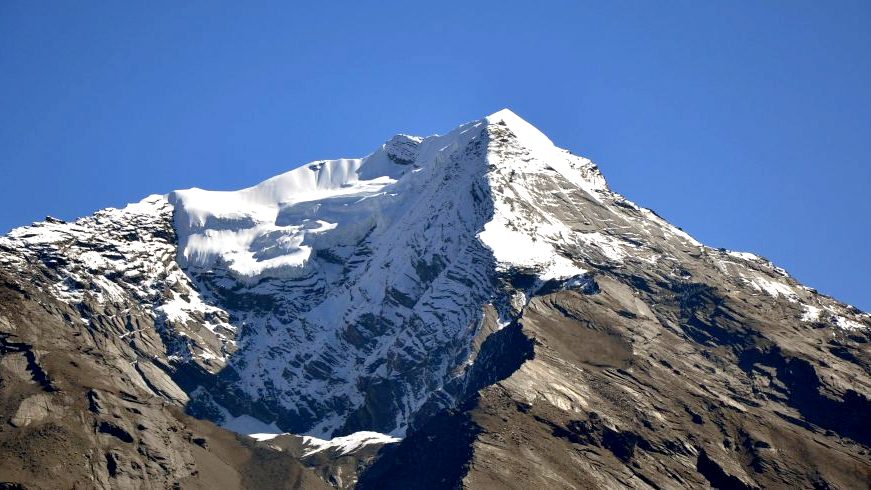
Pisang Peak's allure lies in its balanced offering—a climb that seamlessly weaves trekking and technical ascent. As climbers venture higher, the terrain evolves, shifting from the familiar trails of trekking to the rugged contours of climbing. The journey unfolds amidst a panorama that reveals the regal presence of Annapurna II, IV, and their companions, painting the sky with a symphony of majestic peaks. The views are nothing short of awe-inspiring, an invitation to transcend the ordinary and embrace the extraordinary. Pisang Peak's summit, a culmination of effort and determination, provides not only a triumphant accomplishment but also a vantage point from which to witness the Annapurna region's splendor. In its presence, climbers find themselves enfolded by the Himalayan embrace, where the fusion of adventure and natural magnificence crafts an experience that lingers in the heart and soul long after the journey's end.
Some Facts About Pisang Peak:
- Elevation: Approximately 6,091 meters (19,983 feet)
- Location: Annapurna region
- Mountain Views: Stunning views of Annapurna II, IV, and nearby peaks
- Difficulty: Combination of trekking and climbing; requires basic climbing skills
Chulu East 6,584 meters (21,601 feet), and Chulu West 6,419 meters (21,059 feet)
In the enchanting embrace of the Annapurna region, the Chulu peaks stand as a testament to the diverse realm of Himalayan climbing. Chulu East and Chulu West, like twin sentinels, invite adventurers to embark on an odyssey that spans a spectrum of experiences, from technical ascents to panoramic vistas that resonate with awe-inspiring beauty.

The allure of the Chulu peaks lies not only in their breathtaking surroundings but also in the myriad climbing experiences they offer. The journey to their summits encompasses a tapestry of challenges, each demanding skill, resilience, and a profound respect for the mountains. As climbers ascend, the landscapes unfold like a captivating story, revealing the grandeur of the Annapurna region in all its glory. The views, extending to distant horizons, include peaks that stand as giants of the Himalayan realm.

Chulu West, in particular, emerges as a star in this constellation of peaks. Its ascent is a formidable undertaking, presenting climbers with a challenge that demands both physical prowess and mental fortitude. Yet, the rewards are nothing short of transformative—a summit that offers not only a triumphant accomplishment but also an unrivaled perspective of the surrounding peaks and valleys.
In the heart of the Annapurna region, the Chulu peaks beckon to adventurers, inviting them to dance with the elements, embrace the unknown, and witness the Himalayas' timeless splendor. Each step taken is a brushstroke in a canvas painted with dreams, challenges, and triumphs, crafting an experience that echoes through the ages and imprints the soul with the essence of the mountains.
Some Facts About Chulu East and Chulu West:
- Elevation (Chulu East): Approximately 6,584 meters (21,601 feet)
- Elevation (Chulu West): Approximately 6,419 meters (21,059 feet)
- Location: Annapurna region
- Mountain Views: Diverse panoramic vistas of Annapurna and surrounding ranges
- Difficulty: Challenging yet rewarding climbs; require mountaineering skills
Paldor Peak 5,896 meters (19,344 feet)
Embraced by the serene beauty of the Ganesh Himal range, Paldor Peak emerges as a hidden gem, beckoning those who seek a climbing experience that's both enchanting and serene. Tucked away from the bustling crowds, Paldor Peak presents a path less traveled, inviting adventurers to embark on an expedition that harmoniously blends trekking and climbing, offering a unique and rewarding journey.
Paldor Peak's ascent unveils a captivating narrative that unfolds across a landscape where the echoes of exploration linger in the air. The journey, a fusion of trekking and climbing, traverses varied terrain, creating a symphony of challenges and triumphs. As climbers ascend, the panorama gradually unfolds, revealing the snow-clad majesty of Langtang Lirung and the distinctive silhouettes of the Ganesh Himal peaks. These views, painted by nature's masterful hand, offer a glimpse into the timeless beauty of the Himalayas.

The charm of Paldor Peak lies not only in its natural splendor but also in the sense of solitude it provides. Away from the well-trodden paths, climbers can immerse themselves in the serenity of the mountains, forging a profound connection with the environment and the journey itself. The ascent is a celebration of the mountains' essence, where every step taken is a brushstroke in a canvas of adventure and exploration. In the presence of Paldor Peak's beauty and the whispers of the Ganesh Himal, climbers find themselves united with the spirit of the mountains, crafting an experience that transcends the ordinary and resonates with the extraordinary.
Some Facts About Paldor Peak:
- Elevation: Approximately 5,896 meters (19,344 feet)
- Location: Ganesh Himal range
- Mountain Views: Views of Langtang Lirung and Ganesh Himal
- Difficulty: Less crowded climb with trekking and basic climbing components
Parchamo Peak 6,273 meters (20,574 feet)
Situated within the enchanting Rolwaling region, Parchamo Peak emerges as a pinnacle of technical challenge and panoramic beauty. This peak, shrouded in the mystique of the Himalayas, beckons to those who seek a climbing experience that's as demanding as it is rewarding. With its soaring heights and technical intricacies, Parchamo Peak invites adventurers to embark on a journey that pushes boundaries and elevates perspectives.
The ascent to Parchamo Peak is a masterclass in technical climbing, demanding a fusion of skill, determination, and respect for the mountain's power. As climbers navigate its precipitous terrain and ascend toward the heavens, they are met with a vista that transcends imagination. The surrounding peaks, including the resplendent Gauri Shankar and the ethereal Tashi Lapcha, stand as sentinels of the Himalayan landscape. The views are nothing short of breathtaking—a symphony of nature's grandeur that resonates in the hearts of those who bear witness.
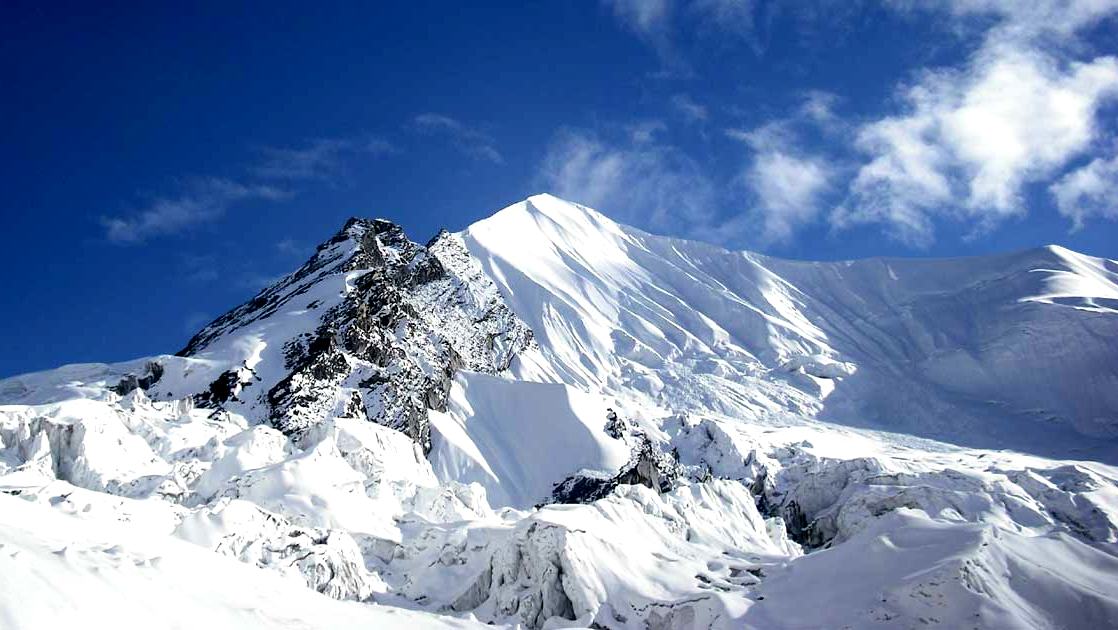
Parchamo Peak's summit is not merely a destination—it's a threshold that leads climbers into the realm of the extraordinary. With each step taken, the journey becomes a communion with the mountains, a dance between human determination and the timeless power of nature. As climbers stand atop Parchamo Peak, they are enveloped by an embrace that unites them with the spirits of the mountains, granting them not only an awe-inspiring vista but also an indelible connection to the essence of high-altitude exploration.
Some Facts About Parchamo Peak:
- Elevation: Approximately 6,273 meters (20,574 feet)
- Location: Rolwaling region
- Mountain Views: Breathtaking vistas of Everest, Gauri Shankar, and Tashi Lapcha
- Difficulty: Technically demanding climb; requires mountaineering skills
Ramdung Go Peak 5,925 meters (19,438 feet)
In the tranquil embrace of the Rolwaling region, Ramdung Go Peak rises as a sentinel of solitude and challenge. This remote gem, tucked away from the bustling trails, calls out to those who yearn for an adventure that transcends the ordinary. Ramdung Go Peak, with its formidable ascent, unveils a journey that is both physically demanding and spiritually enriching.

Ascending Ramdung Go Peak is a testament to the resilience and skill of mountaineers. The climb, shrouded in the mystique of the Himalayas, offers a challenge that demands every ounce of determination and courage. As climbers navigate its rugged paths and confront the intricacies of the ascent, they are rewarded with vistas that stretch beyond imagination. From the summit, a tapestry of beauty unfurls—the iconic Everest stands tall amidst the Rolwaling range, and nearby peaks offer an intimate connection with the Himalayan panorama.
Ramdung Go Peak's summit is more than just an elevation reached—it's a sacred space where the worlds of earth and sky converge. Here, amidst the whispering winds and the towering peaks, climbers find themselves united with the Himalayas' essence. The journey to the summit becomes an odyssey of self-discovery, a pilgrimage that leaves an indelible mark on the soul. Ramdung Go Peak, with its remote splendor and panoramic majesty, becomes a testament to the power of the mountains, where challenges and triumphs merge to create an experience that resonates far beyond the journey's end.
Some Facts About Ramdung Go Peak:
- Elevation: Approximately 5,925 meters (19,438 feet)
- Location: Rolwaling region
- Mountain Views: Awe-inspiring views of Everest, Rolwaling, and nearby ranges
- Difficulty: Remote and challenging climb with technical sections
Naya Kanga (Ganja La Chuli) 5,844 meters (19,173 feet)
The mesmerizing scenery of the Langtang region, where the Naya Kanga, also known as Ganja La Chuli, appears as a beacon of ecstasy and unspoiled beauty. This peak, adorned with both a local name and an adventurous spirit, beckons to those who crave a climb that marries thrill with awe-inspiring vistas.
Naya Kanga's ascent is an invitation to challenge the limits of exploration. As climbers navigate its rugged terrain and navigate technical sections, they embark on a journey that demands skill, perseverance, and reverence for the mountains. With each step taken, the allure of the summit grows stronger, drawing climbers into the realm of the Himalayan gods. And then, as if scripted by nature itself, the summit unveils its gift—a panoramic vista that spans from the regal Langtang Lirung to the distinctive peaks of the Ganesh Himal range.
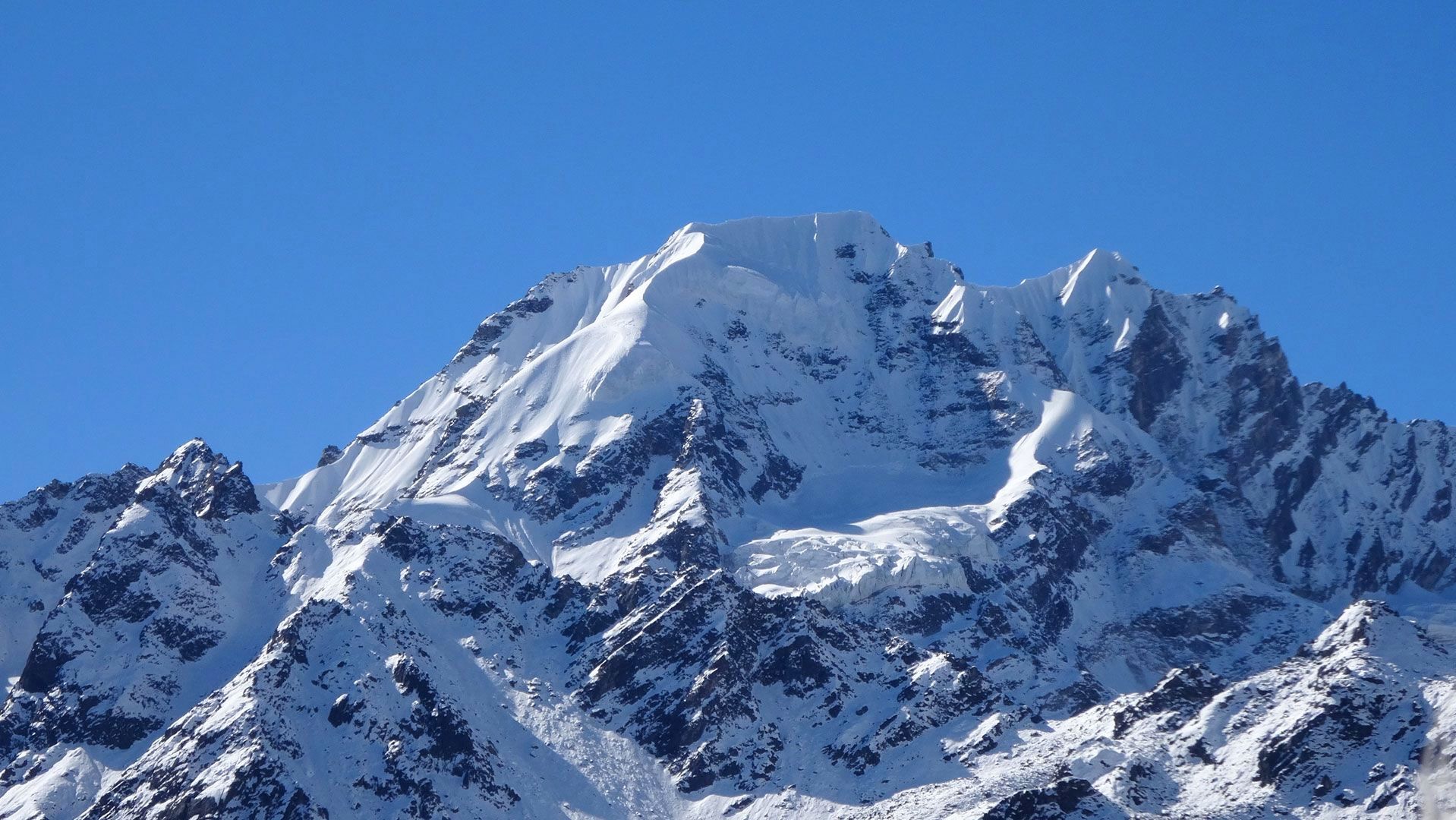
From the summit of Naya Kanga, climbers find themselves suspended between earth and sky, amidst a panorama that reflects the splendor of the Langtang region. Peaks rise like sentinels, each with its own story to tell, each contributing to the tapestry of the Himalayas. Naya Kanga's summit becomes a vantage point where the efforts of the climb are rewarded with vistas that transcend the ordinary and embrace the extraordinary. In its presence, climbers are united with the spirit of adventure, a connection that resonates with the mountains' timeless allure and the indomitable spirit of exploration.
Some Facts About Naya Kanga (Ganja La Chuli):
- Elevation: Approximately 5,844 meters (19,173 feet)
- Location: Langtang region
- Mountain Views: Panoramic vistas of Langtang Lirung and Ganesh Himal
- Difficulty: Suitable for novice climbers, offers a mix of trekking and climbing
Highlights of the 6000-meter peak climbing in Nepal
Climbing 6000-meter peaks in Nepal is a remarkable adventure that offers a blend of challenges, breathtaking landscapes, and a sense of accomplishment. Here are some of the highlights of 6000-meter peak climbing in Nepal:
- Accessible Adventure: 6000-meter peaks provide a fantastic opportunity for both novice and experienced climbers to experience high-altitude climbing without the extreme technicalities of higher peaks. This accessibility makes them an ideal stepping stone for those looking to elevate their climbing skills.
- Varied Landscapes: The journey to these peaks takes climbers through a diverse range of landscapes. From lush valleys and dense forests to alpine meadows and glacial moraines, you'll experience the changing beauty of Nepal's natural scenery.
- Cultural Immersion: Many of these peaks are situated in regions inhabited by ethnic communities with rich cultural traditions. You'll have the chance to interact with local villagers, learn about their way of life, and immerse yourself in the local culture.
- Panoramic Views: The summit views are nothing short of spectacular. From your lofty vantage point, you'll be rewarded with stunning panoramas of the surrounding Himalayan giants, including some of the world's highest peaks.
- Climbing Challenges: While these peaks are generally less technical than their higher counterparts, they still present their own set of challenges. You'll encounter varied terrain, potentially including rock, ice, and snow, which will test your climbing skills and mental fortitude.
- Less Crowded Routes: Compared to some of the more popular high-altitude peaks, 6000-meter peaks often have fewer climbers, allowing for a more serene and intimate climbing experience.
- Physical and Mental Achievement: Conquering a 6000-meter peak is a tangible achievement that requires physical fitness, mental resilience, and determination. The feeling of standing on the summit after putting in the effort is truly rewarding.
- Introduction to High-Altitude Climbing: Climbing these peaks can be an excellent way to gain experience with higher altitudes and acclimatization, preparing you for more challenging climbs in the future.
- Team Bonding: Climbing a peak is often a team effort. Sharing the challenges, triumphs, and stunning vistas with fellow climbers creates strong bonds and lasting memories.
- Personal Growth: 6000-meter peak climbing is not just a physical adventure; it's also an opportunity for personal growth. Overcoming obstacles, facing the elements, and pushing your limits can lead to a deep sense of self-discovery and empowerment.
Climbing a 6000-meter peak in Nepal is a multi-faceted journey that blends the thrill of adventure with the wonder of nature and the camaraderie of fellow climbers. It's an experience that leaves an indelible mark on your memory and heart, reminding you of the raw beauty and grandeur of the Himalayas.
Best Time to Climb 6000-meter peaks in Nepal
The best time to climb 6000-meter peaks in Nepal varies depending on the season, each offering distinct advantages and challenges. Here's a breakdown of the different seasons and their climate conditions:
Spring (March to May): Spring is widely considered the optimal time for climbing 6000-meter peaks in Nepal. The weather is relatively stable, with clear skies, mild temperatures, and less precipitation. As the snow begins to melt, the trails become more accessible, and the lush landscapes come alive with blooming rhododendrons and other wildflowers. The visibility is excellent, providing panoramic views of the surrounding peaks. This season is ideal for both climbing and trekking, as the moderate temperatures and clear weather contribute to a comfortable and enjoyable experience.
Summer (June to August): Summer is the monsoon season in Nepal, characterized by heavy rainfall and higher humidity. Climbing 6000-meter peaks during this time is generally not recommended due to the challenging weather conditions. The trails can become muddy and slippery, and the risk of landslides is higher. While some trekking regions, such as the rain shadow areas of Mustang and Upper Dolpo, are less affected by the monsoon, climbing peaks during this season are still limited due to the unpredictable weather patterns.
Autumn (September to November): Autumn is another excellent season for climbing 6000-meter peaks. The weather is stable, with clear skies and mild temperatures, making it a popular time for both climbers and trekkers. The trails are dry, and the views are unobstructed, offering breathtaking panoramas of the surrounding peaks and landscapes. Autumn is also the post-monsoon season, so the air is clear and fresh, providing optimal conditions for high-altitude climbing.
Winter (December to February): Winter is a challenging time for climbing 6000-meter peaks due to the colder temperatures and increased snowfall at higher altitudes. The trails can be covered with snow, making navigation more difficult and potentially hazardous. However, some climbers with experience in cold-weather mountaineering might opt for winter climbs. It's crucial to be well-prepared with proper gear and equipment to withstand the cold conditions.
Both spring and autumn are considered the best seasons for climbing 6000-meter peaks in Nepal. While each season has its own unique appeal, these transitional periods offer stable weather, clear views, and more manageable trail conditions. However, careful consideration of the specific peak, its location, and individual climbing experience is essential when planning your climbing expedition to ensure a safe and rewarding journey.
Tips and Preparation for 6000 meters peak climbing in Nepal
Climbing a 6000-meter peak in Nepal is a thrilling adventure that requires careful preparation and planning. Here are some essential tips and steps to help you prepare for a successful climb:
- Physical Fitness: Strengthen your cardiovascular and muscular endurance through regular aerobic exercises like running, cycling, and hiking. Incorporate strength training to build your core and leg muscles.
- Altitude Acclimatization: Gradual acclimatization is crucial to prevent altitude sickness. Consider spending a few days in a higher-altitude location before starting the climb. Plan a gradual ascent and include rest days to allow your body to adjust.
- Training Climbs: Undertake practice climbs at lower altitudes to gauge your fitness and acclimatization. These climbs will also help you get accustomed to the gear and conditions you'll encounter.
- Technical Skills: Depending on the peak, you might need basic mountaineering skills such as rope work, ice axe use, and crampon techniques. Consider taking a mountaineering course to gain proficiency.
- Climbing Gear: Invest in quality climbing gear, including proper clothing, mountaineering boots, crampons, ice axes, helmets, harnesses, and ropes. Make sure your gear is well-fitting and comfortable.
- Hydration and Nutrition: Stay hydrated by drinking plenty of water and carrying a water purification method. Pack high-energy snacks and meals that are easy to prepare at higher altitudes.
- Travel Insurance: Obtain comprehensive travel and medical insurance that covers high-altitude climbing and potential evacuation in case of emergencies.
- Local Guides: Consider hiring local guides who are familiar with the area, terrain, and conditions. They can provide valuable insights and enhance safety.
- Permits and Regulations: Obtain the necessary climbing permits and adhere to local regulations. Ensure you're well-informed about the route, weather conditions, and rescue procedures.
- Weather Awareness: Be prepared for rapidly changing weather conditions. Pack waterproof and windproof clothing to stay warm and dry.
- Emergency Plan: Develop a clear emergency plan in case of unexpected situations. Know the location of the nearest medical facilities and communication methods.
- Mental Preparedness: Climbing at high altitudes can be mentally challenging. Stay positive, manage your expectations, and be prepared to adjust your plans if necessary.
- Pack Light: Carry only essential gear to minimize your load. An organized and lightweight pack will help you move more efficiently.
- Environmental Considerations: Respect the natural environment by adhering to Leave No Trace principles. Dispose of waste properly and minimize your impact on the ecosystem.
- Perseverance: Climbing a 6000-meter peak requires determination and resilience. Maintain a steady pace, listen to your body, and know when to rest.
By following these tips and preparing meticulously, you'll be better equipped to tackle the challenges and relish the rewards of climbing a 6000-meter peak in Nepal. Remember that safety is paramount, and a well-planned and well-executed climb will lead to a more fulfilling and memorable experience.
While embarking on the journey to conquer Nepal's 6000-meter peaks is a testament to the indomitable spirit of adventure that drives mountaineers and trekkers alike. These peaks, nestled in the embrace of the Himalayas, offer a captivating blend of challenge, beauty, and cultural immersion. Whether you're a seasoned climber seeking new heights or a novice eager to embrace the thrill of high-altitude exploration, Nepal's 6000-meter peaks provide an avenue to connect with nature's grandeur and test your limits. From the awe-inspiring vistas atop the summits to the camaraderie forged on the trails, the experience of climbing these peaks is a journey that leaves an indelible mark on the heart and soul. As you ascend, you not only conquer the physical obstacles but also awaken a deeper understanding of your own resilience and the boundless allure of the mountains. Every step, every breath, and every moment of triumph is a testament to the remarkable power of human determination and the majestic beauty of Nepal's towering landscapes.
Frequently Asked Questions (FAQs) for the 6000 meters peak climbing in Nepal
Q: What are 6000-meter peaks in Nepal?
A: 6000-meter peaks in Nepal refer to mountains with elevations ranging from approximately 6000 meters to just below 7000 meters. They offer a mix of trekking and climbing experiences, making them accessible to climbers with varying levels of experience.
Q: Do I need climbing experience to climb a 6000-meter peak?
A: While some 6000-meter peaks are suitable for novice climbers with basic trekking experience, others may require more advanced mountaineering skills. It's essential to choose a peak that matches your climbing skills and comfort level.
Q: When is the best time to climb 6000-meter peaks in Nepal?
A: The best seasons are spring (March to May) and autumn (September to November). These months offer stable weather, clear skies, and optimal climbing conditions. Summer (monsoon) and winter are generally less favorable due to challenging weather conditions.
Q: How long does it take to climb a 6000-meter peak?
A: The duration varies depending on the peak and the specific route you choose. Most climbs range from 10 to 20 days, including acclimatization and trekking to the base camp.
Q: What physical fitness level is required for climbing these peaks?
A: Good physical fitness is crucial. Regular cardio exercises, strength training, and endurance-building activities are recommended. Climbers should be prepared for long days of trekking and challenging ascents.
Q: Is altitude sickness a concern on 6000-meter peaks?
A: Yes, altitude sickness is a potential concern when climbing above 3000 meters. Proper acclimatization, gradual ascent, and staying hydrated are essential to minimize the risk. Climbers should be familiar with the symptoms and be prepared to descend if necessary.
Q: Can I climb solo or do I need a guide?
A: While experienced climbers might choose to climb solo, it's recommended to have a guide or join a guided expedition, especially for those with limited climbing experience. Local guides provide safety, local knowledge, and assistance in emergencies.
Q: Are permits required to climb 6000-meter peaks?
A: Yes, climbing permits are required for most 6000-meter peaks. These permits can vary in cost and requirements depending on the peak and location. Make sure to obtain the necessary permits before starting your climb.
Q: How challenging are the climbs on 6000-meter peaks?
A: The level of challenge varies from peak to peak. Some offer non-technical routes suitable for novice climbers, while others require advanced mountaineering skills. Research the specific peak and route to understand the technical difficulties involved.
Q: Can I combine 6000-meter peak climbing with trekking?
A: Yes, many 6000-meter peak climbs are combined with trekking to base camps. This allows climbers to acclimatize, experience the local culture, and enjoy the scenic trails before attempting the summit.
Q: What safety precautions should I take when climbing 6000-meter peaks?
A: Safety is paramount. Adequate acclimatization, proper gear, knowledgeable guides, and familiarity with emergency procedures are essential. Always prioritize your safety and the safety of your team.
Here are some of the most popular 6000-meter peak climbing packages in Nepal.
Mt Ama Dablam Expedition (6,812 m)
Island Peak Expedition (6,160 m)
Mera Peak Climbing (6,476 m)
Chulu West Peak Climbing (6,419 m)
Pisang Peak Climbing (6,091 m)
Singu Chuli Peak Climbing (6,501 m)
If you need any further information, please contact us by email: [email protected], Phone: +977- 985 100 5129 (WhatsApp)




